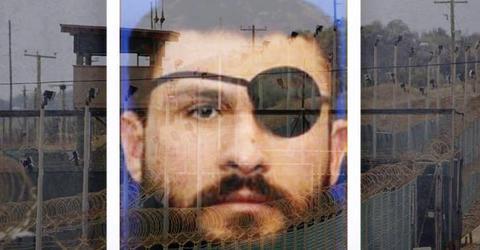Exactly 16 Years Ago, the U.S. Captured Abu Zubaydah, the First Official Victim of the Post-9/11 Torture Program, Who is Still Held at Guantánamo Without Charge or Trial

Torture victim and "high-value detainee" Abu Zubaydah, in a photo taken at Guantánamo and included in the classified military files released by WikiLeaks in 2011. The photo has been superimposed on an image of Guantánamo, where Abu Zubaydah has been held for eleven and a half years. (Source: Anti-Media).
If you can, please make a donation to support our work in 2018. If you can become a monthly sustainer, that will be particularly appreciated. Tick the box marked, "Make this a monthly donation," and insert the amount you wish to donate.
By Andy Worthington, March 28, 2018
Exactly 16 years ago, on March 28, 2002, an event took place that has had dreadful repercussions ever since, when Pakistani and American agents raided a house in Faisalabad, Pakistan and captured Abu Zubaydah (Zayn al-Abidin Muhammad Husayn), creating a torture program especially for him, which was then applied to dozens of other prisoners seized in the U.S.’s brutal and pointless "war on terror."
A Palestinian born in Saudi Arabia in 1971, Zubaydah had traveled to Afghanistan to join the mujahideen in the Afghan civil war (1989-1992) that followed the retreat of the Soviet Union after its ten-year occupation. In 1992, he was severely injured by an exploding mortar shell, suffering shrapnel wounds and severe memory loss. For over a year, he was also left unable to speak.
Although he eventually recovered sufficiently to become a logistician for Khalden, an independent training camp run by Ibn al-Shaykh al-Libi, which closed around 2000 when al-Libi refused to allow it to come under the control of Al-Qaeda, FBI agents who interviewed him after his capture had no doubt that the mortar damage had caused permanent damage. They also knew that he was a kind of travel agent for Khalden, and not number 3 in Al-Qaeda, as the CIA and the Bush administration mistakenly thought. (Al-Libi, meanwhile, tortured into telling lies that the U.S. used to justify its illegal invasion of Iraq, was eventually returned to Libya, where Col. Gaddafi imprisoned him and later killed him).
Nevertheless, the Bush administration refused to listen to reason, and decided that he had to be tortured. He was flown to Thailand, where the CIA had set up its first "black site," and where he was waterboarded on 83 separate occasions and also subjected to other disgusting and disgraceful forms of torture under the direction of two former U.S. military psychologists, James Mitchell and Bruce Jessen.
When the Thai government tired of allowing Thailand to be used for abuses that the U.S. was unwilling to do on its own soil, he was shunted around a variety of other "black sites," including one in Poland, one in Guantánamo (known as Strawberry Fields), and others in Morocco, Lithuania and, probably, Afghanistan, before ending up back at Guantánamo, this time in military custody, with 13 other alleged "high-value detainees" in September 2006.
Since then, while six of the men who arrived with him in September 2006 have been put forward for military commission trials, which are mired in seemingly endless pre-trial hearings, largely because of the torture to which they were subjected, which the government still seeks to hide, he and six others continue to be held without charge or trial. Under Obama, they were eventually allowed to have their cases reviewed, but the review process set up in 2013, the Periodic Review Boards, which is similar to a parole process, approved their ongoing imprisonment. With ten other prisoners, he is now asking a judge to rule on whether, 16 years after Guantánamo opened, their endless imprisonment is "arbitrary and unlawful and amounts to 'perpetual detention for detention’s sake.'"
Just two weeks ago, Joe Margulies, who is one of Abu Zubaydah’s lawyers, wrote about his client for TIME. Margulies wrote, "I represent Abu Zubaydah, who was the first person imprisoned at a CIA black site and the first to have his interrogation 'enhanced.' He was subjected to all of the approved techniques and many that were not. In a bit more than three weeks in August 2002, he was waterboarded 83 times, suspended from hooks in the ceiling, forced into a coffin for hours at a time in a gathering pool of his own urine and feces, crammed into a tiny box that would've been small even for a child, bombarded with screaming noise and cold air, compelled to stay awake for days on end, and 'rectally rehydrated.'"
Margulies also wrote, "Because of what he was made to endure, Abu Zubaydah suffers from frequent seizures, the origin of which cannot be determined. He is tormented by sounds that others do not hear, and cannot remember simple things that others cannot forget. Because his condition is classified, there is much about his welfare that the United States will not let me say. They have authorized me to report, however, that I am 'very concerned' about his health."
Joe Margulies' article followed the news that Gina Haspel, currently the Deputy Director of the CIA, had been chosen by Donald Trump to be its Director. Haspel didn’t torture Abu Zubaydah, but from what we understand she was in charge of the "black site" in Thailand from October 2002 until its closure in December 2002, and, as Joe Margulies put it, she was "present when another prisoner, Abd al-Rahim al-Nashiri, was subjected to similar torture, including waterboarding."
Margulies' article was carefully non-judgmental. "We do not know," he wrote, "whether she approved of the torture that had taken place before she got to Thailand or that took place after she arrived, and if she did, whether her approval was enthusiastic or begrudging. We do not know whether she made any attempt to restrain the two psychologists [Mitchell and Jessen], and if so whether her attempts were overruled by authorities elsewhere."
As he also explained, "In fact, we do not even know the limits of her authority. One CIA cable, for instance, indicates that, even if she had wanted to, she could not have stopped the torture on her own. The Senate Torture Report, by contrast [whose executive summary was published in December 2014], claims she most certainly had that authority, and in fact that her authority was 'final'; according to the Senate, she was the only person who could’ve ended the torture."
Margulies also stated, "In short, all we know is that she appears to have been in charge of a site where my client had previously been tortured, and supervised the site while another man was tortured. And make no mistake: it was torture. We ought not mince words about that. It was legally wrong and morally bankrupt, and my client will bear the physical and psychological scars for the rest of his life."
He added that although, for some people, "Haspel’s supervisory presence at a secret prison where human beings were tortured is enough to disqualify her," "we need less knee-jerk condemnation and more sober, careful assessment. That is why we have a confirmation process."
That confirmation process, as he also noted, needs to establish Haspel’s exact role in the destruction of videotapes showing the torture of Abu Zubaydah and Abd al-Rahim al-Nashiri, contravening a judge’s ruling, and, as he also put it, we need to know "her current view."
As he explained, "It is entirely possible that her position on 'enhanced interrogations' has changed since 2002. In fact, given the course of events, we should hope that it has. The CIA tortured my client because they believed — apparently in good faith — that he was a senior member of al Qaeda who, among other misdeeds, had been involved in all of the organization’s prior attacks and had particular expertise in resisting torture. They were wrong. We now know, and the U.S. has repeatedly admitted, that Abu Zubaydah was not a member of al Qaeda, that he was opposed to its ideology and that his protestations of ignorance were not evidence of a supernatural capacity to resist torture, but proof that the torturers had their facts wrong. In light of this, it is certainly worth asking whether Haspel believes the Agency’s sickening experiment with torture was a mistake."
Unfortunately, while Joe Margulies shows admirable balance in his view of Gina Haspel, there is no sign that, having recognized that Abu Zubaydah "was not a member of al Qaeda," and "was opposed to its ideology," the U.S. government has any intention of treating him fairly, by either releasing him or putting him on trial.
While ten of the 41 men still held are going through or have been through the military commission process, and while five others were approved for release but are still held, the 26 others — including Abu Zubaydah — remain in a limbo that has no justification, and that still seems to have no end, and that, every day, ought to be a source of shame for all decent Americans, just as it was 16 years ago when Abu Zubaydah was first seized in Faisalabad.




